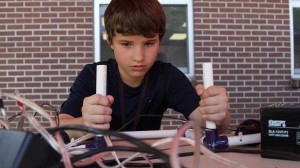OXFORD, Miss. – A dozen middle school students recently spent a week delving into deep-sea science and technology at a summer camp sponsored by the University of Mississippi’s Center for Mathematics and Science Education and the National Institute for Undersea Science and Technology at the UM Field Station.
Students in the Seafloor Science and ROV camp had opportunities to engage in electronics challenges, team-building and mock ocean exploration and research activities using remotely operated vehicles, or ROVs, to simulate research on an ocean vessel.
Geoff Wheat, director of the National Institute for Undersea Science and Technology, or NIUST, helped develop the program that aids young, aspiring scientists to better understand the equipment used to gather information from the deep sea.
“Oceanographers in general do not have the training to fix their electronic equipment if it breaks at sea” Wheat said. “This camp helps young students interested in ocean research get a better appreciation of all aspects of sea-going activities and an understanding of the basic electronics that make their equipment work”
Ocean science is a fascinating field that teachers can tell kids about, but the students get a better understanding of the work involved in an oceanography career by spending a week doing an actual oceanography or ocean engineering, said Michelle Edwards, marketing and outreach specialist for NIUST and the field station.
“We are trying to help kids understand the job opportunities they have in math and science by giving them a real-world application,” Edwards said.
The students spent the early part of the week learning the ins and outs of undersea ROV technology, including materials, design and fabrication, and sampling equipment. Students finished each activity with scientist’s log entries.
Since the camp was not be able to head to the coast, the weekly lessons culminated in the hands-on experience of operating an undersea ROV in the university’s Turner Center pool on Thursday (June 19).
“The students will build ROVs this week and operate them in the Turner Center pool and get a ‘deep ocean’ experience,” Edwards said.
This is the inaugural session of this camp, said Wheat, who came up with the idea while participating in his children’s kindergarten class. He has worked on the camp’s modules for the past eight years. He hopes to hold the camp in more places and continue teaching children about opportunities in ocean engineering and research.
Joe Rea, a seventh-grader from Mooreville, realized he wants to know more about underwater engineering because of the camp.
“Everything I’ve learned about underwater engineering is fun so far,” Rea said. “I enjoyed actually building the ROVs.”
Participants in the camp were: Katelyn Booker, Alphonse Johnson, Jahra Martin, Ciarra Nicholson and Olivia Toles of Coffeeville Middle School, Addison Floyd and McKayla Hodges of Okolona Middle School, John Stewart and James Jubera of Oxford Middle School, Joe Rea of Mooreville Middle School and Elijah Hollis of Fairview Elementary School in Asheville, North Carolina.
The UM Field Station offers opportunities for research in aquatic and terrestrial ecology. Located 11 miles northeast of the Oxford campus on Bay Springs Road, the 740-acre station lies in a scenic, three-mile-long, V-shaped valley surrounded by wooded hills and teeming with natural springs and seeps. To learn more about research and education programs at the Field Station, go to http://baysprings.olemiss.edu/.
